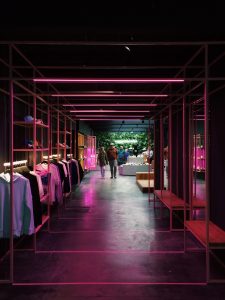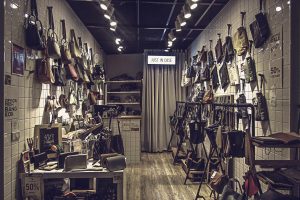Nearly all the data our brains process (83 per cent) comes in during our feeling of sight. That is appropriate. We are overwhelmingly observable when digesting information compared to our other perceptions. If you have ever mulled over the significance of your retail interior design, then this statistic must grab your attention.
Consider it this way: Each inch of your shop costs you. Now, consider the regions in your store which have the capability to earn you cash. You can not afford to have unappealing and unsuccessful in-store displays.
That is where visual merchandising comes from. Visual merchandising is a time-tested retail interior stylist theory that concentrates on improving the aesthetic appeal of a service or shop to attract customers and boost sales.
There are a number of tricks of the trade that merchants can use to maximize every square foot of a shop. Thus, let us look at ways to optimize your merchandising to improve earnings.
One.
Light plays an important part in enticing a prospective customer into your store. Additionally, it has the capacity to elicit powerful emotions and affect the way that your product is absorbed. Our brains — being hyper-visual — feature certain emotions to certain colours. While green and blue are calming, orange and red are believed arousing.
Research suggests individuals are more inclined to remember a colour over an item or merchandise. The identical study says shoppers create a buying decision within 90 minutes of interacting with a commodity, and more than 60 per cent of their evaluation is based on colour alone.
But if you see your neighbour’s window screens are filled with reds and oranges, then proceed with a darker palette to make a stark design comparison.

Two.
Smart visual cues guide your client through your shop strategically and supply them with all the information they need when they want it. Consider signage as a powerful go-to supply of advice as soon as your sales staff is occupied with other clients.
The human eye span is about eight seconds. Thus, ensure that your client can find what they’re looking for at the moment, or you risk losing them.
Tips:
- Play with graphics, vision, and iconography in order to add character to a shop’s visual identity and draw your client in. Your hints might serve up the data clients need while still having an extension of your brand — have fun together.
- Make sure your signage could be digested in a glance. Use big, bold lettering wherever possible.
Three.
Lighting shapes the total atmosphere of your shop and assists to draw a person’s attention to a specific area. Similar to signage, it may elegantly direct the shopper into the regions of the shop that you need to emphasize.
There are 3 techniques in light makeup: main light, accent lighting, and ambient light.
Principal lighting is your general illumination of your shop. Accent lighting brings the shopper’s attention to a certain screen. Ambient lighting will be more striking since it plays light from darkness to make an intriguing impact.
Current research looked at light’s impact on consumer behaviour. The study found that clients spent time in regions of the shop that had warmer light and the average earnings per client increased by 1.93 per cent every time a lively lighting setup has been released.
Tips:
- Be careful not to put your principal lighting too dim
- Accent lighting ought to be used sparsely to prevent cannibalizing its own effect. Be considerate about which products you need to emphasize.
Four.
How you display products can draw customer attention and can also help them visualise seeing an item in their own home decor and design pre-purchase. Begin with telling a narrative. You could appeal to the new mum by putting a fancy crib with hux baby clothing and a fluffy blanket. Items may be grouped according to colour use or scheme, but the objective is to tie it together.
Experiment with varying heights to make visual comparison and capture customer attention and boost involvement with your goods.
This makes it a lot easier for the client to interact with this item.
Produce a definite focal point and place supporting goods cascading beneath it.

Five.
Window displays are a wonderful spot to let shoppers know what is fresh, which products are best sellers, and what is available. Consider this as a controlled platform at which you are able to communicate with potential customers
Research indicates that shows can increase earnings by 540 per cent, and also a well-planned hotspot can raise earnings by 229 percent. Hotspots are the regions of your shop that receive the most traffic and also therefore are the most visible.
Tips:
- Use replicating elements to make a strong display and exhibit a selection of your offerings
- Ensure there is sufficient space for the products you are showcasing
- Aim to upgrade your window at least once each month to keep bringing customers into your shop. Bring your current stock up front and centre to lure repeat clients into finding out what is new.
Incorporating Technology to Visual Merchandising
If the past couple of decades have taught us anything, it is the effect of electronic media in retail is on an incline.
Over half of those surveyed (63 percent ) at a current report confessed that electronic signage grabs their attention. Digital components such as interactive touchscreens that allow shoppers to search, navigate, and share continue to be incorporated into in-store screens. Wearable tech may also add an extra layer of interactivity for tech-savvy customers.
Experimenting using the aforementioned tried-and-true techniques is a excellent place to begin, but keep your eyes open for new tech which could enhance your visual merchandising blend later on.
